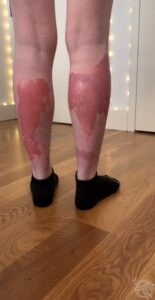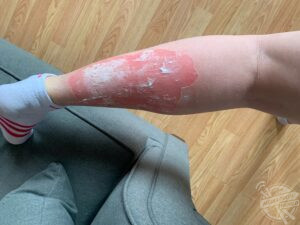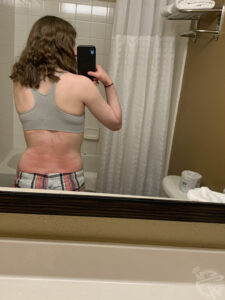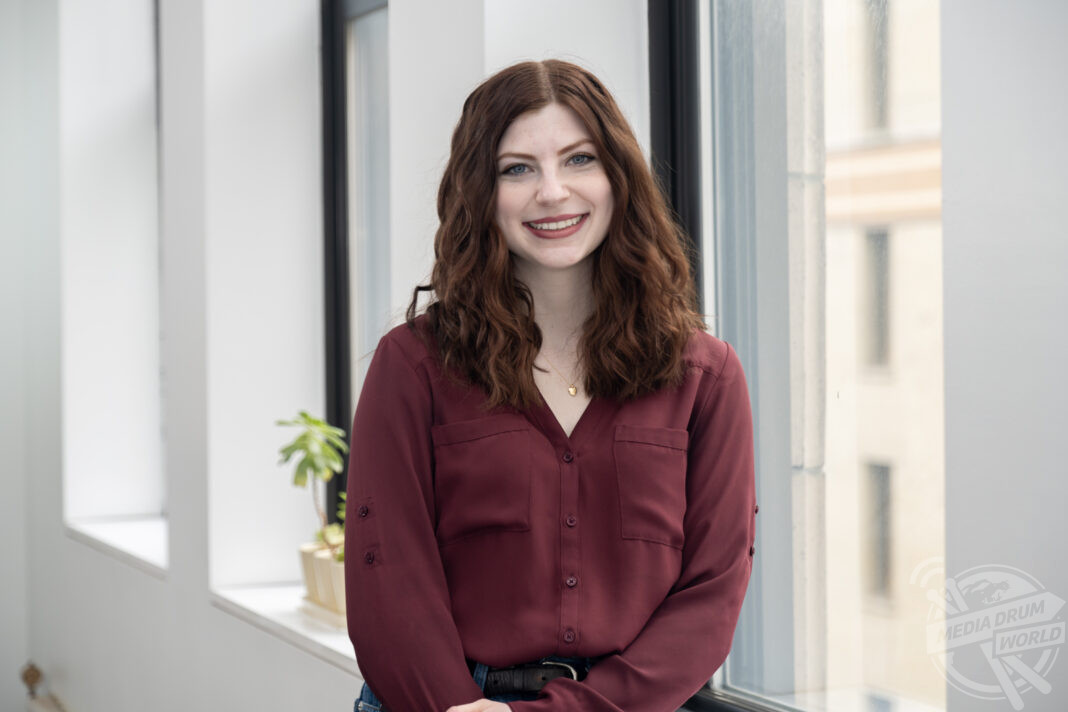By Shannine O’Neill
THIS WOMAN suffers a rare skin disease that has sentenced her to a lifetime of being unable to lie or sit normally and the slightest bump can shred her skin but since revealing all online the reaction of trolls has left her feeling dehumanised.
Communications Manager Becca Joy Stout (24) from Brooklyn, New York, has a skin condition called Epidermolytic Hyperkeratosis, affecting one-in-300,000 people worldwide, which she has had since birth.
To raise awareness for her condition and help others in a similar situation, Becca launched a TikTok profile with over 21,000 followers and her most popular video being viewed by over 472,000 people, however since finding her following she must tolerate ignorant trolls calling her “gross” and dehumanising her by asking intrusive questions like whether she can have sex when her skin can not tolerate friction.
Becca has experienced chronic pain, blisters and even her skin tearing away from her body from doing the simplest things such as sleeping and sitting. She must sleep on her stomach, with her arms at either side of her body, in order to stop her skin ripping and blistering overnight.

Becca has even been left with a limp from her open wounds on her leg due to the muscle underneath stretching the skin over the wound, causing shooting pain up her leg.
Although Becca has to live with this unbearable pain every day, she has become accustomed to it and has sat through school, University and an office job, knowing that although she will get blisters and ripped skin on her legs where she has sat, she prioritises her education and career.
Becca was easily and quickly diagnosed with her condition at birth because her mother also suffered from the same hereditary condition.
Her skin disorder occurred from a mutation in the Keratin 10 gene. Her skin cells do not bond together like they should, causing them to grow too quickly.
Becca’s mutation means that her skin is especially prone to blisters and open wounds while doing the average things that most people take for granted, such as sitting for extended periods of time, dancing, exercising, walking, sleeping, and even standing in the one position for too long can have detrimental effects on Becca’s health and wellbeing.
Becca especially cannot tolerate her skin to have friction, as this has been known to tear the first layer of her skin completely off, creating an open wound susceptible to infections. This even includes the use of plasters, as the adhesive will rip the skin off entirely.
At times, the pain has been so unbearable, that Becca has had to open blisters into wounds in order to stop the pain and start the healing process.
After peeling the skin, the wound will be extremely sensitive, painful, and weepy for a day or two. During that time, she wraps it in gauze and steroid creams or Neosporin and changes the bandages regularly.
Having constantly open wounds are not only extremely painful, but can cause a much deeper threat of getting infected, which Becca has had to deal with many times before, but says as long as she cleans the wounds consistently, she is usually able to manage the wounds.
Different seasons even affect her skin differently, such as her skin being much more prone to dying up, splitting and cracking in the winter, whereas her skin is much more prone to tears in the summer.
Becca has learned to manage her pain through different techniques and treatments, such as scrubbing her skin and using specialised lotions daily.
“On a multiple-times a day basis, I use lotions, thicker ones in the winter, lighter ones in the summer, and a combination in the fall and spring months”, she said.
“I go through lotions so quickly that a large tub that would last most people months will probably only last me a couple weeks if I am lucky.

“Every day in the shower, I use moisturising body washes and an antiseptic wash to get rid of as much bacteria as possible and once a week, I scrub off my excess skin with a pumice stone or stone-like pedicure brush. This is done while soaking in a bathtub. I generally soak for about twenty minutes before beginning. It generally takes me about forty minutes to scrub my whole body, so all in all, this is about an hour-long process.
“I take Tylenol when I am in extreme pain to help control the swelling and pain, and I use a handful of prescribed steroid creams when I have an infection. I also use gauze wraps to bandage open wounds when I have them.”
This constant pain has put Becca’s life on a stand-still since infancy, as she cannot do the average things that most people her age do as part of their day-to-day routines, such as getting the subway to work or to sit for hours in an office, as sitting for long periods of time causes Becca unbearable pain.
Becca has found it difficult to keep-up with her peers her whole life, and says that although the pain of her condition is horrific, the struggles she deals with in relation to spending time with friends is the worst part of her condition.
Alongside her inability to keep up with her friend’s lives, Becca has also noticed strangers constantly staring at her and commenting on her skin.
From a young age, Becca remembered her classmates at school calling her names and hitting her with books in order to “see what happened” when they did so.
As she has aged, Becca has noticed that the attention from others was less physical and more intrusive as strangers would approach her and ask her personal questions about her skin, making her feel as though they were treating her as less-than-human.
This especially got worse after she started posting videos explaining her condition and what her life looks like every day because of it, to TikTok, under her account name @becxjoy.
Becca has had people both online and in person throw incredibly hurtful insults at her, even calling her “gross” and disgusting. She’s also had very insensitive questions asked of her by complete strangers, such as if she can have sex because of her condition.
“It is a very rare condition. As of now, the likelihood of having it is 1 in 200,000 to 300,000 according to this U.S. National Library of Medicine”, she said.
“My skin disorder occurs as a mutation in the Keratin 1 or Keratin 10 gene. In my case, it was a mutation on the Keratin 10 gene.
“In the simplest of terms, my skin cells do not bond together like they should, and they proliferate too quickly. The combination of these things mean that my skin is especially prone to blisters and open wounds.

“Compression (like from sitting, lying down, or having fabric pressing against me) causes my skin to blister in raised red patches that are sore and hot to the touch and often look like sunburn.
“Friction (like brushing up against or bumping into something) causes my skin to tear. I do not get brush burns or rug burns, instead, the top layer(s) will pull away, which is especially the case if I already have a blister, but it still frequently happens, even when there is no blister in sight.
“I also cannot use band-aids because the adhesive tears my skin off. I also am extremely prone to skin infections, even when I do not have large open wounds because I get microtears in my skin, such as from shaving.”
Becca says that the worst thing about her condition is the social stigma or dynamics surrounding it.
“I am very frequently in pain. However, the inconveniences that accompany that pain are very annoying”, she said.
“For instance, when I am in pain, and it is hard to move or get dressed, getting myself to work via the subway or sitting in meetings can be especially painful.
“The pain also limits my ability to hang out with friends since spending long hours dancing in a club or sitting and chatting can cause me pain.
“Extreme pain can also make me miss out on activities I enjoy doing, such as working out.”
Although Becca has experienced hardships with keeping up with her friends, she has also felt ostracised from society, due to other people’s reactions and comments.
“I may walk with a limp or not be able to twist or move my arm. My skin may look sunburnt when it is actually blistered. I may have open wounds or visible gauze wraps”, she said.
“Although these are all common for me, I have found that it is not so much these things but rather other people’s reactions to them that is really uncomfortable and even painful.

“These visible marks of disability encourage acquaintances and random strangers to approach me to give uninformed and unwelcome advice, ask some of the most intrusive questions, and make incredibly hurtful comments about my skin’s appearance.
“Therefore, the worst things about living with my skin disorder occur as a result of my skin disorder but not necessarily as direct symptoms of my skin disorder, instead, they are caused by the changes in my ability to do the things I want to or need to do and by the interactions I have with other people as a result of my differences.”
Despite these incredibly tough set-backs Becca has endured throughout her life, she remains strong and determined to make the most of her life, even though her days are filled with pain and unwanted attention.
“I work full-time in a hybrid office setting, I am a current graduate student, and I also do a handful of other activities, like playing piano, writing, and exercising. From the outside looking in, my life does not look any different because of my skin disorder”, she said.
“However, based on experience and observations, I think I have a much different perspective than many other people and go about my life differently than other people without my disorder.
“I strategically plan my outfits based on everything I might do that day, such as what material I might end up sitting on, what I will be doing, how long I will be out, and what I need to carry with me (bags can also rub my skin raw at my shoulders).
“I am more cautious to avoid bumping into other people. Especially in a busy city like New York, it can be very dangerous for me because anyone bumping into me or accidentally hitting their bags into me can cause my skin to tear off.
“Despite how cautious I am, I also think I have a more carefree perspective when it comes to pain in general.
“I am much more than most of the people I know to try a new workout activity or do something like horseback riding and martial arts that I know will result in pain. I know that I am going to feel pain for doing nothing, so I would rather feel that pain knowing that I did something enjoyable. Pain, for me, is inevitable, so I would prefer it on my own terms.”
Becca has remained strong-willed and positive throughout her journey with her rare disease, even giving guest lectures about her skin condition in order to inform people about her struggles and perseverance. She is currently studying a Disability Studies master’s program at the City University of New York.
ENDS










